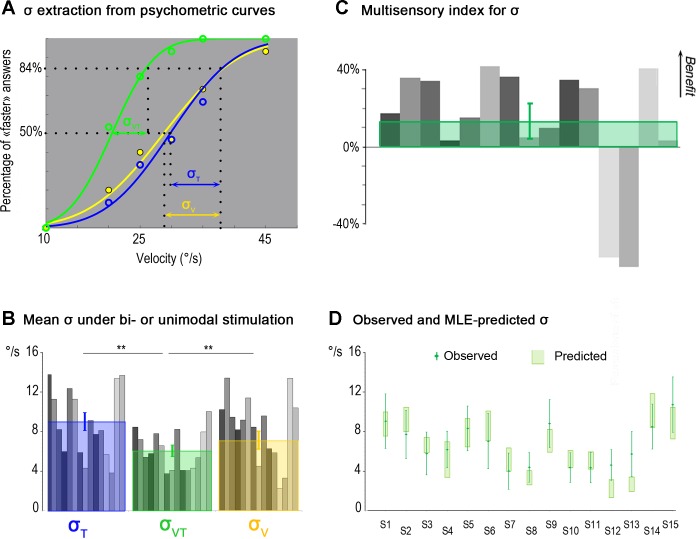Fig. 5.
Comparison of velocity discrimination thresholds during tactile, visual, and visuotactile stimulation. A: extraction of σ from psychometric curves. Psychometric curves of one representative participant obtained by fitting the probabilities of perceiving the illusion as faster than the reference movement with a cumulative Gaussian distribution for the tactile stimulation (T; blue curve), visual stimulation (V; yellow curve), and visuotactile stimulation (VT; green curve) are shown. The discrimination threshold (σ) is the difference between the stimulation velocities leading to the faster answer 84.13% of the times and 50% of the times, and it is inversely related to the slope of the psychometric function. B: mean σ in bi- or unimodal stimulation. Mean individual values of σ (gray bars) and mean (±SD) values of σ extracted from the whole population data (N = 15) for tactile (blue square), visual (yellow square), and visuotactile (green square) stimulation are shown. For the mean σ values, significant differences were found between the bimodal and each of the two unimodal conditions (*P < 0.05; **P < 0.01). C: multisensory index for σ. Individual (gray bars) and mean multisensory index (green square) for σ (N = 15 participants) are shown. Positive and negative values correspond, respectively, to a multisensory benefit or loss in the discrimination performance of the participants with respect to their most efficient unimodal performance. D: comparison between observed and MLE-predicted σ. A comparison between observed σ in visuotactile stimulation and σ predicted by the MLE model for the 15 participants (S1 to S15) is shown. The green diamonds correspond to the observed data, and error bars are SDs. No significant difference was found between predictions and observations of σ (P = 0.55; not significant). Light green rectangles represent 95% confidence intervals (CIs) computed using the following bootstrap procedure. Choice data were resampled across repetitions (with replacement) and refitted 1,000 times to create sample distributions of the threshold for each psychometric function and for the predicted visuotactile parameters. CIs were directly estimated from these bootstrap samples (percentile method).

